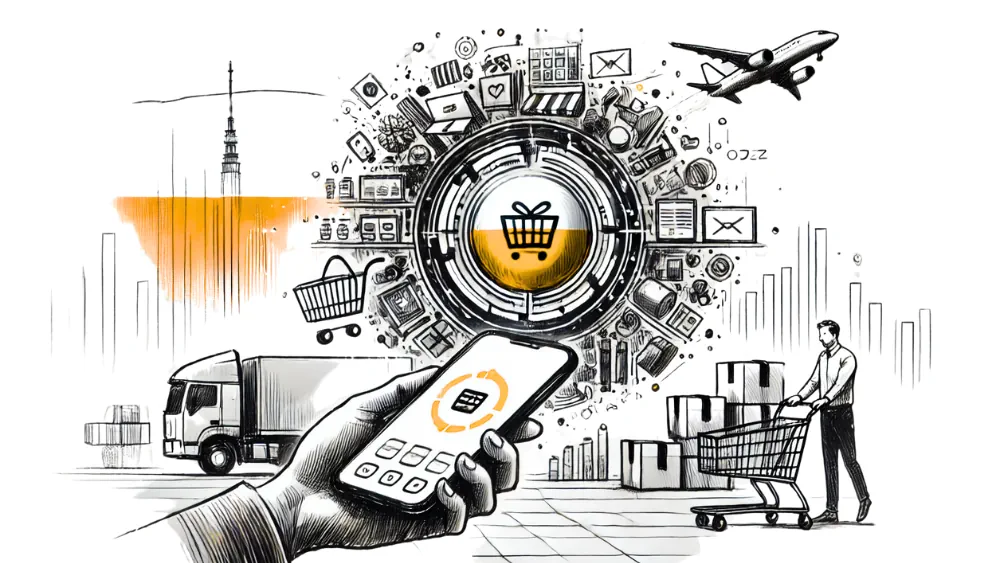 illustration: bing.com/create
illustration: bing.com/createMore and more Poles are choosing online shopping as a daily way to meet their needs. Online shopping has become an integral part of everyday life due to its convenience and wide range of products. The COVID-19 pandemic accelerated this shift, forcing consumers to adapt to new conditions, which has cemented these habits even after restrictions eased.
- 75.8% of Poles shop online at least a few times a month.
- Residents of large cities, such as Katowice and Gdańsk, spend the most on online shopping.
According to SAMOSEO`s report authors SAMOSEO, high income levels, better infrastructure, and greater availability of logistics services may explain these differences. In these cities, online shopping has become almost the norm, while in smaller towns, traditional shopping in physical stores still plays a significant role. These differences may also stem from higher consumer awareness and easier access to modern technologies.
Most Frequently Purchased Products
Electronics is the most popular product category in Poland. The popularity of electronics can be attributed to society`s rapid digitalization and the growing demand for modern devices. Consumers invest in computer equipment, smartphones, and other mobile devices, driven by remote work and the desire to own the latest technology. At the same time, competition in the online electronics market helps drive prices down, further stimulating demand.
- Electronics (38%): The most popular category, with strong demand growth for computer equipment and mobile devices.
- Clothing (30%): The second most popular category, with increasing interest in premium brands.
- Cosmetics (20%): Popular among both women and men, focusing on natural and eco-friendly products.
Poles increasingly choose online clothing shopping due to the wide range of products, often at lower prices than in traditional stores. Many consumers also appreciate the ability to compare offers and take advantage of promotions. This trend is also supported by the growth of second-hand platforms and increased interest in sustainable fashion, which attracts younger consumers who are conscious of fashion`s environmental impact.
Factors Influencing Purchase Decisions
SAMOSEO analysts explain the growing importance of reviews and ratings posted by other users as a need to minimize the risks associated with online shopping. Influencer recommendations, opinions on forums and social media, and product reviews on online stores are gaining importance because they help consumers make more informed decisions.
- Online Reviews (60%): A key decision factor, especially among younger consumers. Trustworthy reviews and recommendations are increasingly valued.
- Price and Promotions: Attractive discounts and special offers remain a primary motivator for purchases.
Price remains one of the most important factors in purchase decisions. The report confirms that Poles are still particularly sensitive to promotions and deals, which is not surprising given the rising cost of living. Numerous sales, discount coupons, and loyalty programs attract customers to online stores that offer competitive prices. For many consumers, online shopping is also a way to save money by comparing prices and accessing deals not available in physical stores.
Consumer Concerns
Poles who shop online, especially for more expensive items, worry that products might arrive damaged, which can lead to additional difficulties with returns and complaints. In response to these concerns, more online stores are working to improve packaging processes and partner with trusted courier companies to ensure safe delivery.
- Product Damage (43%): The biggest concern related to online shopping, especially for more expensive items.
- Fraud and Cybercrime (35%): A significant percentage of consumers express concerns about data security during transactions.
In an era of increasingly advanced technology, threats like data theft and phishing attacks are becoming more common. Poles are increasingly looking for stores that offer extra transaction security, such as two-factor authentication or encrypted connections, to minimize risk. This challenge compels sellers to invest in advanced data protection technologies.
Changes in Shopping Habits
SAMOSEO report authors highlight that, compared to previous years, trust in online shopping has grown due to improved service quality, a wide range of products, and positive user experiences. More people who previously feared online shopping now regularly use this shopping method. This shift is also due to educational efforts that inform consumers about transaction security and their rights in case of purchase issues.
Social media also plays an increasingly significant role in the shopping process. Influencers, social media ads, and shopping functions directly integrated into platforms like Instagram and Facebook attract younger generations. Thanks to this, consumers can discover new products, brands, and trends, influencing their purchasing decisions. Online sellers who effectively use these platforms can expect an increase in reach and profits.
The Future of Online Shopping in Poland
The report points to the continued growth of e-commerce in Poland, especially given consumers` increasing awareness and expectations for service quality. The rise of technologies such as artificial intelligence (AI) and big data will enable increasingly accurate customization of offers to individual consumer needs.
Companies will invest in tools to analyze customer behavior to offer personalized products and services. Personalization will become a key element in building customer loyalty and increasing conversions.
In the future, companies are expected to increasingly engage in creating personalized shopping experiences, including adapting content on websites and providing product recommendations based on previous purchases.
Analysts predict that the growing demand for fast and reliable deliveries will lead companies to invest in logistics infrastructure development. Warehouse automation, drone deliveries, and expanding pick-up point networks (PUDO) are just some of the growth directions that will reduce delivery times and costs.
Meanwhile, consumers` growing ecological awareness will drive companies to adopt more sustainable practices, such as minimizing packaging, optimizing delivery routes, and promoting eco-friendly products. In response to these needs, more environmentally friendly delivery options, such as emission-free deliveries and packaging recycling programs, are expected to develop.
The full SAMOSEO report "E-shopping Habits of Poles" is available at
https://samoseo.pl/nawyki-e-zakupowe-polakow-raport-2024/
COMMERCIAL BREAK
New articles in section Media industry
Journalism in the age of AI. Why people prefer humans over machines
Krzysztof Fiedorek
Only 12% of people accept news created solely by AI, while 62% prefer those written by humans. At the same time, only 19% notice labels indicating the use of artificial intelligence, while younger audiences ask AI to explain the content to them. These are the findings of the Reuters Institute report on artificial intelligence in media.
Why do we believe fakes? Science reveals the psychology of virals
KFi
Why do emotions grab more attention than evidence, and why can a fake authority overshadow scientific data? Researchers from Warsaw University of Technology, Jagiellonian University, and SWPS University in Poland sought the answers. Here are their findings.
Investigative journalism in Europe. Newsrooms face pressure
KFi, Newseria
Media and political representatives point to the difficult situation of investigative journalism in Europe. Newsrooms are reluctant to invest in this segment due to high costs and the large amount of time and effort required. Most of all, however, they fear legal proceedings.
See articles on a similar topic:
Mobile games in Poland. Market value and forecasts
Newseria, KFi
In 2030, the number of mobile game users in Poland may exceed 7.1 million, and market revenue will approach 470 million dollars, according to Statista data. As the number of gamers increases, the market for mobile gaming devices is also expanding.
Poles on the Internet. RegionyNEXERY 2024 Report
KFi
The Internet not only connects people but also changes their daily habits in ways that seemed unattainable just a few years ago. Over 40% of Poles work remotely, and IoT devices are gaining popularity in rural areas. The #RegionyNEXERY 2024 report reveals surprising facts about the digital reality.
Media Subscriptions to Replace Advertising. TMT Predictions 2018
BARD
Some publishers already consider attempts to generate revenue from online advertising a waste of time. According to the "TMT Predictions 2018" report by Deloitte, by the end of 2018, half of all adults in developed countries will have at least two online media subscriptions.
Artificial intelligence in newsrooms. Three realities of the AI era in media
Krzysztof Fiedorek
According to a report by the European Broadcasting Union, many newsrooms already use AI but still do not fully trust it. Audiences do not want "robotic" news, and the technologies themselves though fast can be costly, unreliable, and surprisingly human in their mistakes.





























